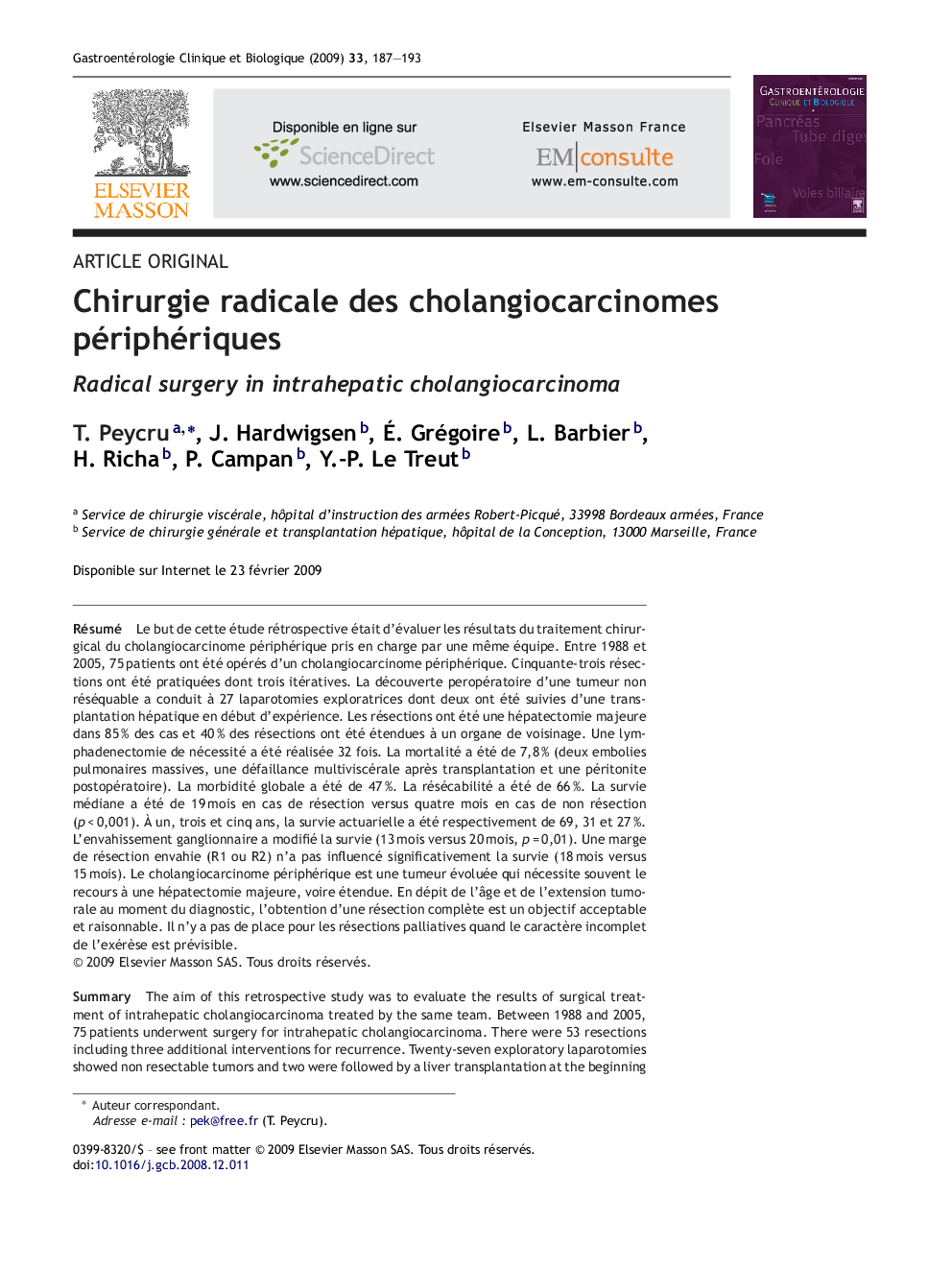| Article ID | Journal | Published Year | Pages | File Type |
|---|---|---|---|---|
| 3290547 | Gastroentérologie Clinique et Biologique | 2009 | 7 Pages |
RésuméLe but de cette étude rétrospective était d’évaluer les résultats du traitement chirurgical du cholangiocarcinome périphérique pris en charge par une même équipe. Entre 1988 et 2005, 75 patients ont été opérés d’un cholangiocarcinome périphérique. Cinquante-trois résections ont été pratiquées dont trois itératives. La découverte peropératoire d’une tumeur non réséquable a conduit à 27 laparotomies exploratrices dont deux ont été suivies d’une transplantation hépatique en début d’expérience. Les résections ont été une hépatectomie majeure dans 85 % des cas et 40 % des résections ont été étendues à un organe de voisinage. Une lymphadenectomie de nécessité a été réalisée 32 fois. La mortalité a été de 7,8 % (deux embolies pulmonaires massives, une défaillance multiviscérale après transplantation et une péritonite postopératoire). La morbidité globale a été de 47 %. La résécabilité a été de 66 %. La survie médiane a été de 19 mois en cas de résection versus quatre mois en cas de non résection (p < 0,001). À un, trois et cinq ans, la survie actuarielle a été respectivement de 69, 31 et 27 %. L’envahissement ganglionnaire a modifié la survie (13 mois versus 20 mois, p = 0,01). Une marge de résection envahie (R1 ou R2) n’a pas influencé significativement la survie (18 mois versus 15 mois). Le cholangiocarcinome périphérique est une tumeur évoluée qui nécessite souvent le recours à une hépatectomie majeure, voire étendue. En dépit de l’âge et de l’extension tumorale au moment du diagnostic, l’obtention d’une résection complète est un objectif acceptable et raisonnable. Il n’y a pas de place pour les résections palliatives quand le caractère incomplet de l’exérèse est prévisible.
SummaryThe aim of this retrospective study was to evaluate the results of surgical treatment of intrahepatic cholangiocarcinoma treated by the same team. Between 1988 and 2005, 75 patients underwent surgery for intrahepatic cholangiocarcinoma. There were 53 resections including three additional interventions for recurrence. Twenty-seven exploratory laparotomies showed non resectable tumors and two were followed by a liver transplantation at the beginning of the study. Major hepatectomy was performed in 85% of resections while hepatectic resection was extended to an adjacent organ in 40%. A lymphadenectomy was performed in 32 cases. Mortality was 7.8% (two massive pulmonary embolisms, one mutiple organ failure after transplantation and one post-operative peritonitis). Global morbidity was 47%. Resectability was 66%. In case of surgical resection, the median survival rate was 18 months versus 4 months without resection (p < 0.001). Actuarial survival rates at 1 year, 3 years and 5 years were 69, 31 and 27% respectively. Positive nodes decreased the survival rate (13 months versus 20 months, p = 0.01). A positive margin (R1 or R2 resection) did not significantly decrease the survival rate (18 months versus 15 months). In conclusion, intrahepatic cholangiocarcinoma is a tumor that often requires a major or an extended hepatectomy. Complete resection is an acceptable and reasonable goal, whatever the patient's age. This radical surgical approach can prolong survival. Palliative surgery is not an option if incomplete resection is predicted.
